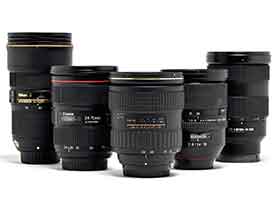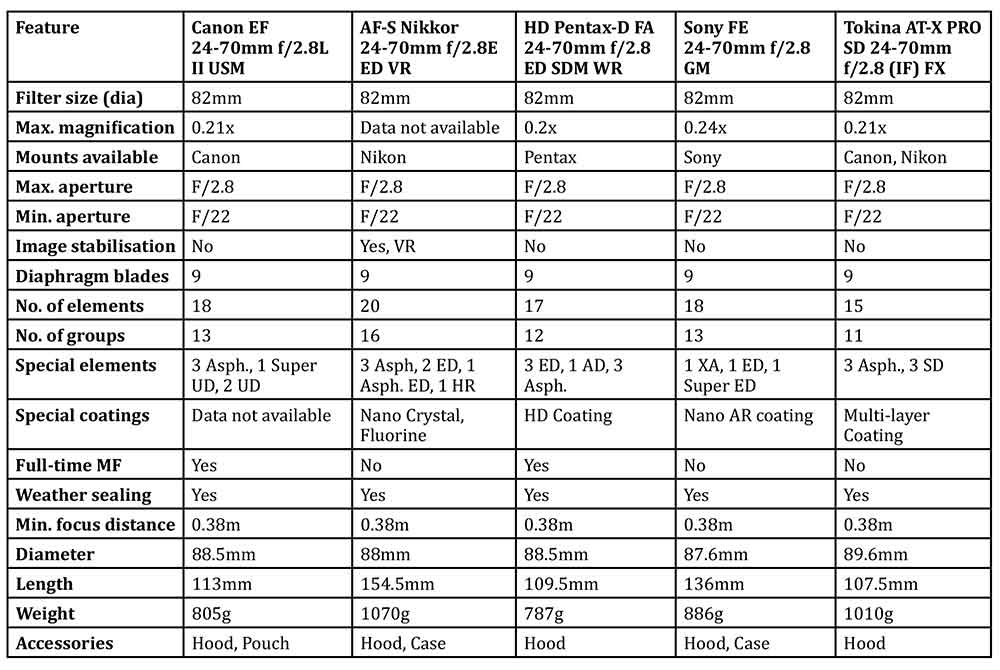 The 24-70mm is probably the most used zoom range in full frame systems. For most of us who have grown beyond the quality of inexpensive kit lenses, the 24-70mm f/2.8 lens presents a desirable longterm goal. This month, we requested all major lens manufacturers to send their premium standard zoom lenses for a comparative review along with the most appropriate bodies. Sigma expressed their inability to send its latest Art series lens since it has not yet been launched in India, and we are disappointed that we couldn’t have a piece from one of the best-rated lens series. The lenses that made it to our test bench on time are Canon EF 24- 70mm f/2.8L II USM, AF-S Nikkor 24- 70mm f/2.8E ED VR, HD Pentax-D FA 24-70mm f/2.8 ED SDM WR, Sony FE 24-70mm f/2.8 GM and Tokina AT-X PRO SD 24-70mm f/2.8 (IF) FX.
The 24-70mm is probably the most used zoom range in full frame systems. For most of us who have grown beyond the quality of inexpensive kit lenses, the 24-70mm f/2.8 lens presents a desirable longterm goal. This month, we requested all major lens manufacturers to send their premium standard zoom lenses for a comparative review along with the most appropriate bodies. Sigma expressed their inability to send its latest Art series lens since it has not yet been launched in India, and we are disappointed that we couldn’t have a piece from one of the best-rated lens series. The lenses that made it to our test bench on time are Canon EF 24- 70mm f/2.8L II USM, AF-S Nikkor 24- 70mm f/2.8E ED VR, HD Pentax-D FA 24-70mm f/2.8 ED SDM WR, Sony FE 24-70mm f/2.8 GM and Tokina AT-X PRO SD 24-70mm f/2.8 (IF) FX.
Design and Build Quality
All the lenses, being the pride of the respective companies, have been constructed with the best of workmanship, and the premium feel repeats across the brands, not giving us a chance to pick out one. The lenses differ in physical dimensions, the Nikon being the tallest, followed by Sony and the other three almost identical in height. However, all the lenses accept 82mm filters.
Key Features
The following table will give you an idea of how the lenses compare in key features. You can see that the features are more-or-less evenly matched. Both Pentax and Sony use in-body (sensorshift) image stabilisation and so their lenses do not feature optical image stabilisation. Canon uses OIS, but decided not to incorporate it with this lens for reasons better known to them.
Nikon was the only lens in this test that features OIS in the form of Vibration Reduction. However, it would be unfair to give points for OIS when others too do the job equally well with in-body image stabilisation. The advantages, if any, will be evident in the performance tests. All data have been taken from the websites of the respective manufacturers.
Ergonomics
Here also, all the lenses were evenly matched in user-friendliness. All lenses except the Sony, feature focus distance scales. The Tokina lens uses the focus clutch mechanism to switch between the focus modes. The Pentax had the best grip for focus and zoom rings, while the Tokina came a close second. The other three lenses were almost equal in grip.
Performance
The Canon lens was mounted on a 5DS R body while the Nikon and Tokina (Nikon mount) were tested on a D810. The Pentax lens was combined with a K1 body, while Sony sent an Alpha 7 II body to test their lens. The companies were asked to send ‘suitable’ bodies since it would allow them to send the cameras that performed best with these lenses. All lens correction options were switched ‘On’ since all current models of full frame cameras offer this feature and hence the final image quality depends on the combination of lens and body. The test results would also indicate how compatible the lens is with the camera.
Autofocus: For this test, we kept the lenses at their widest apertures, and the camera was kept in Aperture priority mode. ISO was fixed at 100 and the central AF point was selected. The Tokina and Pentax were slightly louder than the rest. Both the Nikon and the Sony were fastest in focussing and near-silent. The Canon and Tokina came second, while the Pentax took a split second more than these lenses.
Darkening of Corners: We compared the darkening of corners at f/2.8. The Pentax lens was clearly the best in controlling the darkening. We did not observe any trace of darkening in this lens. Canon came second with a tinge of darkening visible at the extreme corners. Both the Sony and the Nikon had the darkening spread out from corners to about 50 percent of the frame, however, the difference in light intensity was minimal. The Tokina produced strong darkening at the corners.
While corner darkening is a common occurrence at the widest aperture, it is important to note how a lens manages to control it when the lens is stopped down. We chose f/5.6 as the second point of comparison. While Pentax, Tokina and Canon lenses managed to eliminate the darkening completely, Nikon retained a little bit of darkening while the Sony left the corners a wee too dark.


